Creation Museum (part 1)
Alice laughed. “There’s no use trying," she said: “one CAN’T believe impossible things.”
“I daresay you haven’t had much practice,” said the Queen. “When I was your age, I always did it for half-an-hour a day. Why, sometimes I’ve believed as many as six impossible things before breakfast.”
—from Through The Looking Glass by Lewis Carroll
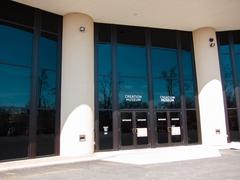
While crossing Ohio, I stopped for a visit to the infamous Creation Museum, located in Petersburg, Kentucky, on the outskirts of Cincinnati, Ohio.
This museum exists to put forth a particular religious position: Young Earth Creationism, the notion that the world is 6,014 years old and every word in the Bible is literally true. The museum starts from that assumption, and twists and contorts observable truths and accepted scientific ideas to fit that assumption. If you are wondering who in the heck would go to such a thing, I’ve got some news for you: it was crowded like Times Square.
This is not some half-assed roadside curiosity—it’s a big-scale, big-money complex meant to impress. It’s clean, comfortable, and welcoming; everyone is very nice, and no one preaches at you; the exhibits are slick and well-executed. There is a full-fledged planetarium for an extra fee, which was pretty well booked up for several hours after my arrival, so I didn’t attend. There is a restaurant and a coffee bar. The security guards are armed.

There is a dinosaur out in front of the building, to lure in the kids.
Dinosaurs are featured heavily here: kids love dinosaurs, and kids need to be indoctrinated, so hit ’em with the dinosaurs early and often.
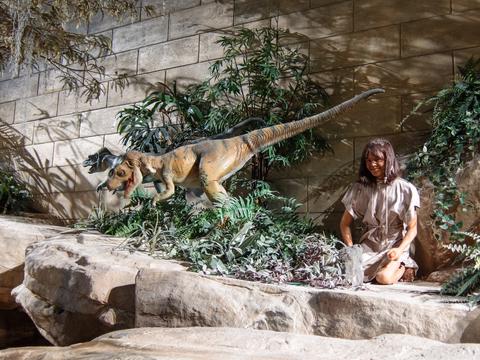
At the entrance we get a taste of what’s to come. In this exhibit, a vegetarian velociraptor doesn’t eat Eve.
A vegetarian velociraptor? In the Garden of Eden? Yes, fear not, this will all be explained during your visit.
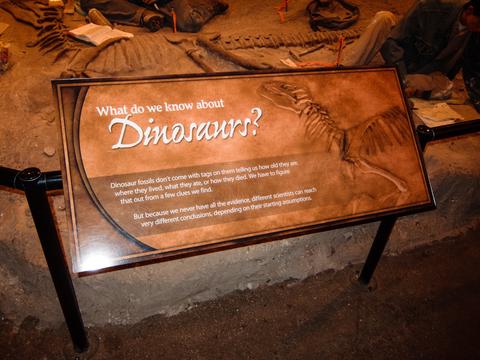
Here we get the foundation: the notion that science is all just a matter of opinion, depending on your point of view.
Scientists, the museum contends, must start from the assumption that everything in the Bible is literally true, and twist all observations to fit that story, or else their conclusions will be wrong.
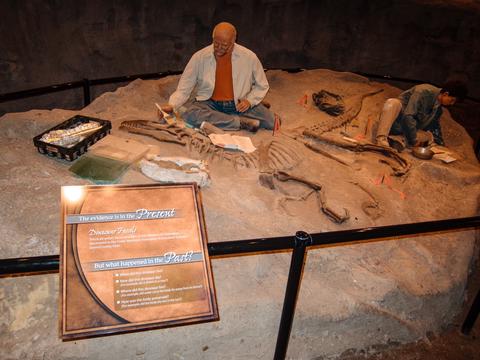
So, archæologists who determine a dinosaur fossil to be millions of years old are simply all wrong, and the ones who say it’s just a couple thousand years old are right because they are starting from the assumption that they must be that old. It’s a big stretch to call such people “scientists,” and as you’ll notice while passing through the exhibits, facts that can’t live up to the standard of literal Scripture are simply ignored.
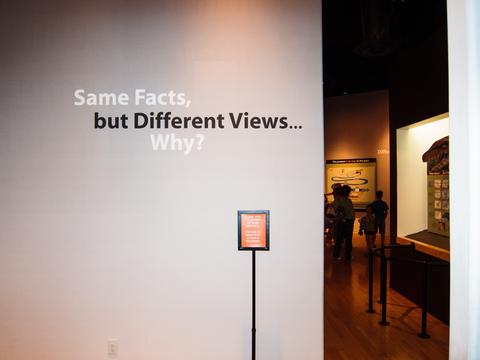
“Same facts, but Different Views. Why?” This is a method of lying I call the “Fox News Approach”: take the thing you want people to believe, and state it as undisputed fact while asking an entirely different question. If you say something over and over like this—for example, “Same facts”—your audience will assume it is simply known to be true.
They don’t want you to notice that they’re not using the same facts, they want you to assume they are. This part of the museum is here to get you into the frame of mind to believe what’s ahead.

Here we further establish science as a matter of opinion, putting forth the notion of two viewpoints on equal footing (like a talking-head segment on cable news), with only one agreeing with the undisputed Word of God.
Notice that “Human Reason” is the bad guy here. We’re supposed to believe what we’re told, not what is actually true.
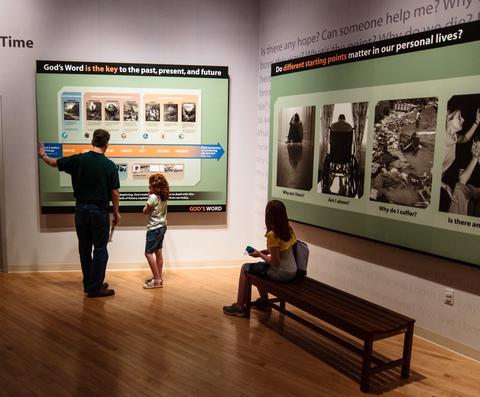
Children being indoctrinated.
Notice the amount of reading involved in a tour of this museum. Most of the exhibits include (or are) a lot of reading material.
On the right is a presentation telling us we should buy the story they’re selling because it offers easy answers to difficult questions. This is a method of lying I call “Innocence By Association.” They’re borrowing standard Christian beliefs that are likely already shared by much of their audience, and making it sound as though people who believe it should also accept their position.
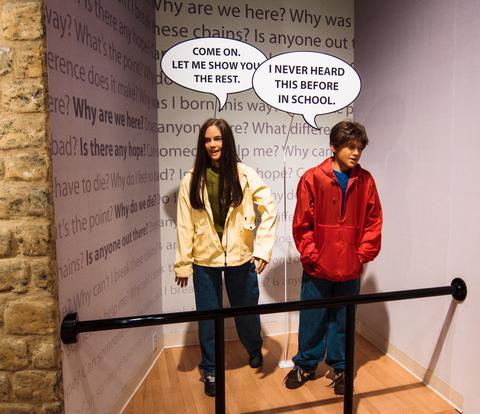
This is not a Photoshop job. It’s an exhibit, speech bubbles and all, telling the kids how excited they should be to be here and how useless school is.
No, really, this is an exhibit.
Remember, the answers are easy, so they must be true.

Moses with the Ten Commandments, and friends.

Paul the Apostle. We’re still laying the groundwork here, presenting things the average Christian will already be comfortable with.
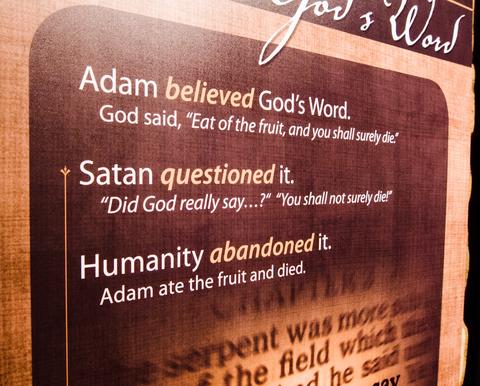
This is more stuff borrowed from mainstream Christianity, but it’s actually more important than that: a major theme in the Museum’s exhibits is that everything bad is a result of Adam’s sin—that’s the foundation for just about everything.
What strikes me about this is “…you shall surely die,” and “Adam ate the fruit and died.” Of course, Adam didn’t die at this point: “die” is metaphorical for falling from the grace of God. A metaphor? But I thought it was all literally true? (Or were they supposed to live forever until they messed it all up?)
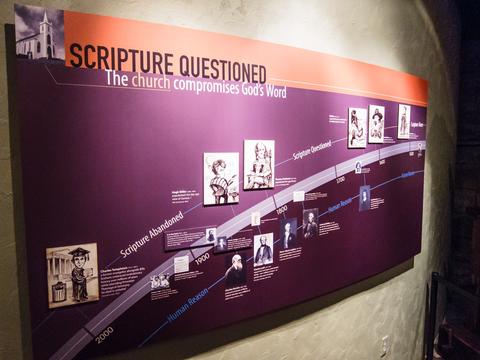
Here we have a timeline of man questioning Scripture. Modern society has abandoned God and thus is in bad shape.
Of course, when the overwhelming majority of Americans are Christians, and there’s no real sign that this is changing, it’s not exactly a given that we have abandoned God, but this is the message: we’ve established the Christian foundation with the audience, and now even Christians must be convinced that their Christianity isn’t good enough, that they are part of the problem too.

The Bible has survived over the ages, which is evidence that it’s special.
The Bible, according to the museum, is literally true, word for word, and can’t possibly contain any metaphors or explanations geared to a Bronze Age audience wondering where the sun goes at night, presented in terms they could understand.
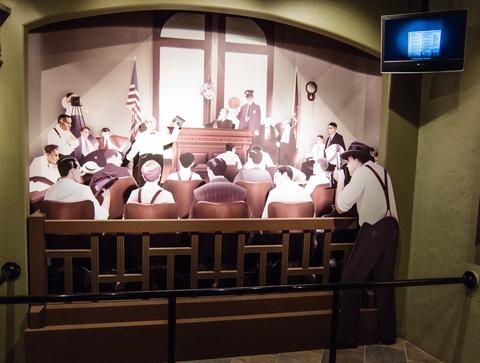
This exhibit is about the Scopes Monkey Trial. A television plays a continuous video loop, indoctrination style, telling us about the horrible people who fought against teaching God’s word, and informing us that the movie Inherit the Wind deliberately twisted events to make Christians look bad.
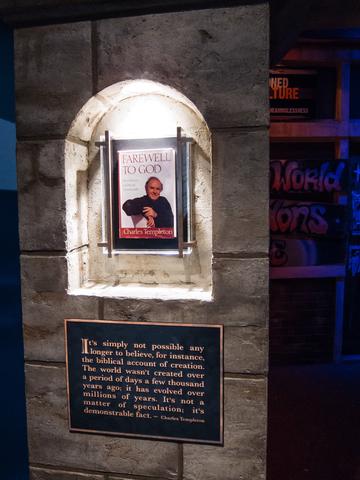
Now we arrive at the portion of the Museum dedicated to showing us how bad the world has become and how far from God we have fallen. At the entrance, this book, “Farewell to God” by Charles Templeton, is given as an example of horribleness.
Of course, this conflates rejection of the Bible as literal truth with total rejection of God.

Beyond that door is the result of our abandonment of Scripture. Our sin looks like a dark alley, apparently. This is meant to show us how bad we’ve made everything, and I guess a dark city alley is every parent’s worst nightmare.
In truth, it looks like a cool stage set for a modern version of “West Side Story.”
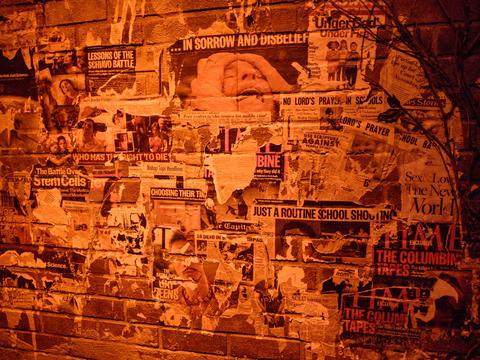
On the wall in the alley are several collages of newspaper and magazine clippings showing the evils of the modern world.
This is a method of lying I call “Guilt By Association.” They take things everyone thinks are bad—school shootings, terrorist attacks—and put them next to the things they want you to think are bad: homosexuality, gay marriage, abortion, premarital sex, stem cell research, and teaching of evolution.

Apparently dark alleys are the place for porn, too. I wonder how many parents have had to answer the question, “Mommy, what does XXX mean?” while walking through here.
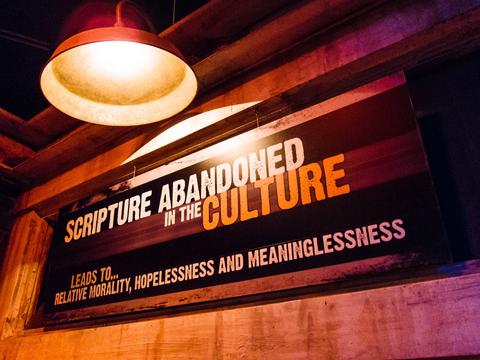
Relative morality, hopelessness, and meaninglessness. Such are the perils of abandoning Scripture.
Also, sin is apparently red.

These folks appear to be trying to convince someone to enter the Scary Place. Come on—of all the dark alleys I’ve seen, and I’ve seen some, this one is by far the cleanest.

A child alone in the dark alley. This couldn’t be more perfect if it were actually an exhibit—but, alas, the child is real.

Have you ever seen a dark alley lit so perfectly, with such attractive colors? It makes sin look pretty nice.
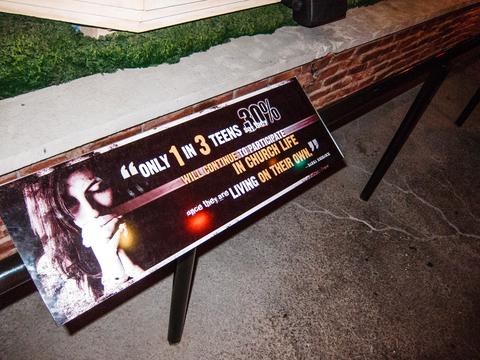
“Only 1 in 3 teens say they will continue to participate in church life once they are living on their own.”
Uh-huh, and I’m sure their parents said the same thing when they were teenagers, and their parents before them. This is a method of lying I call “The Persecution Complex,” where the large majority need to convince themselves they are being oppressed. It’s also popular on Fox News.
Audio and video loops play in this room. One repeatedly says, “More than half of women have had sex outside marriage.” No, they’re saying that’s a bad thing. Notice how it’s only a problem for the women.
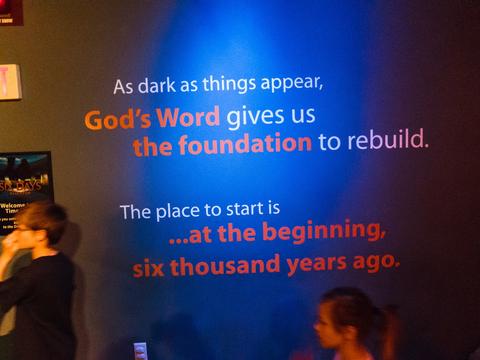
Now that we’ve seen just how bad the world is, and why it’s so bad, we move on to the next stage, where we go back to the beginning and learn the right way.
This is the end of the Museum’s introduction, so here I will end Part One. Check back soon for Part Two, when things start to get weird. If you thought they were already weird, well, just wait.